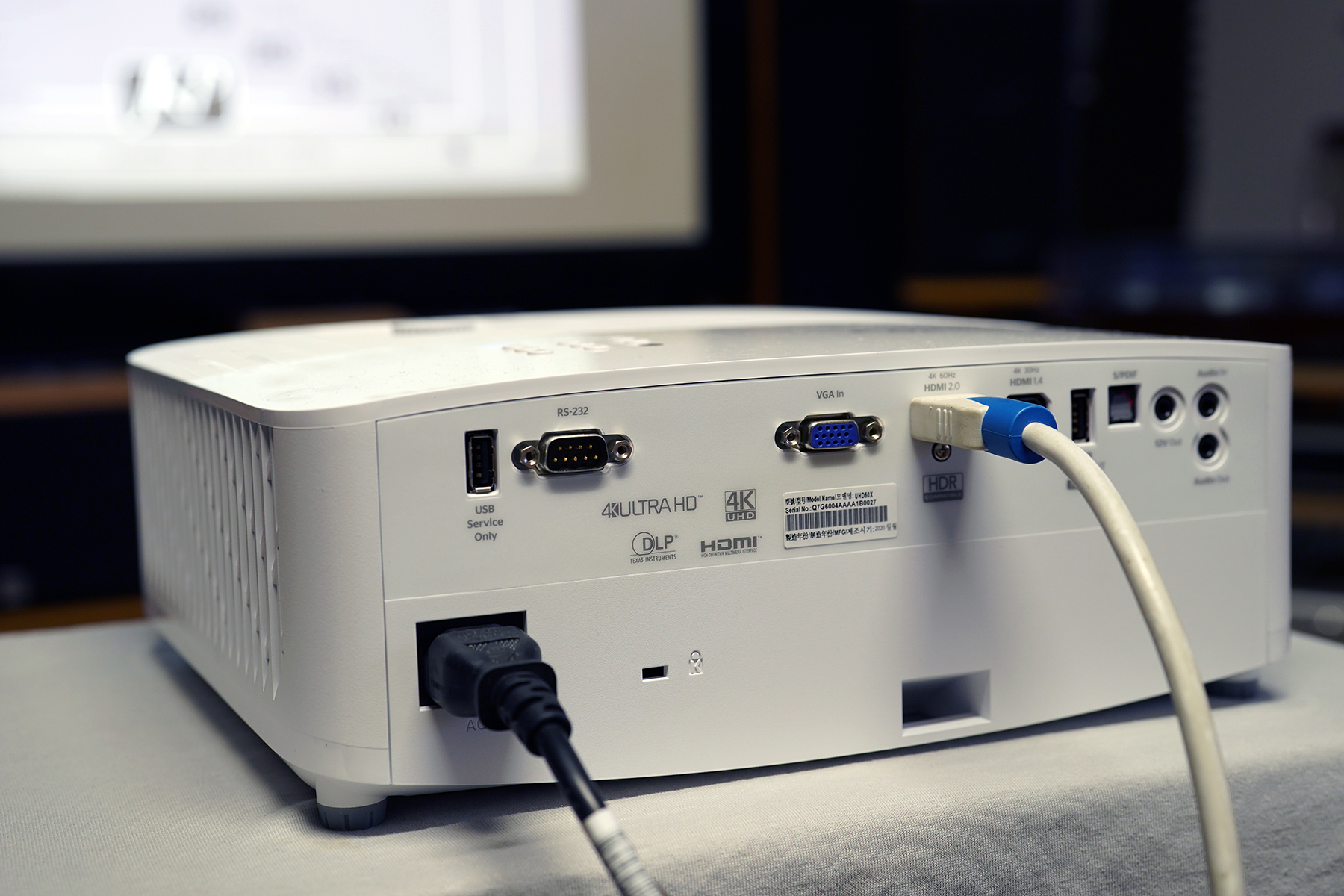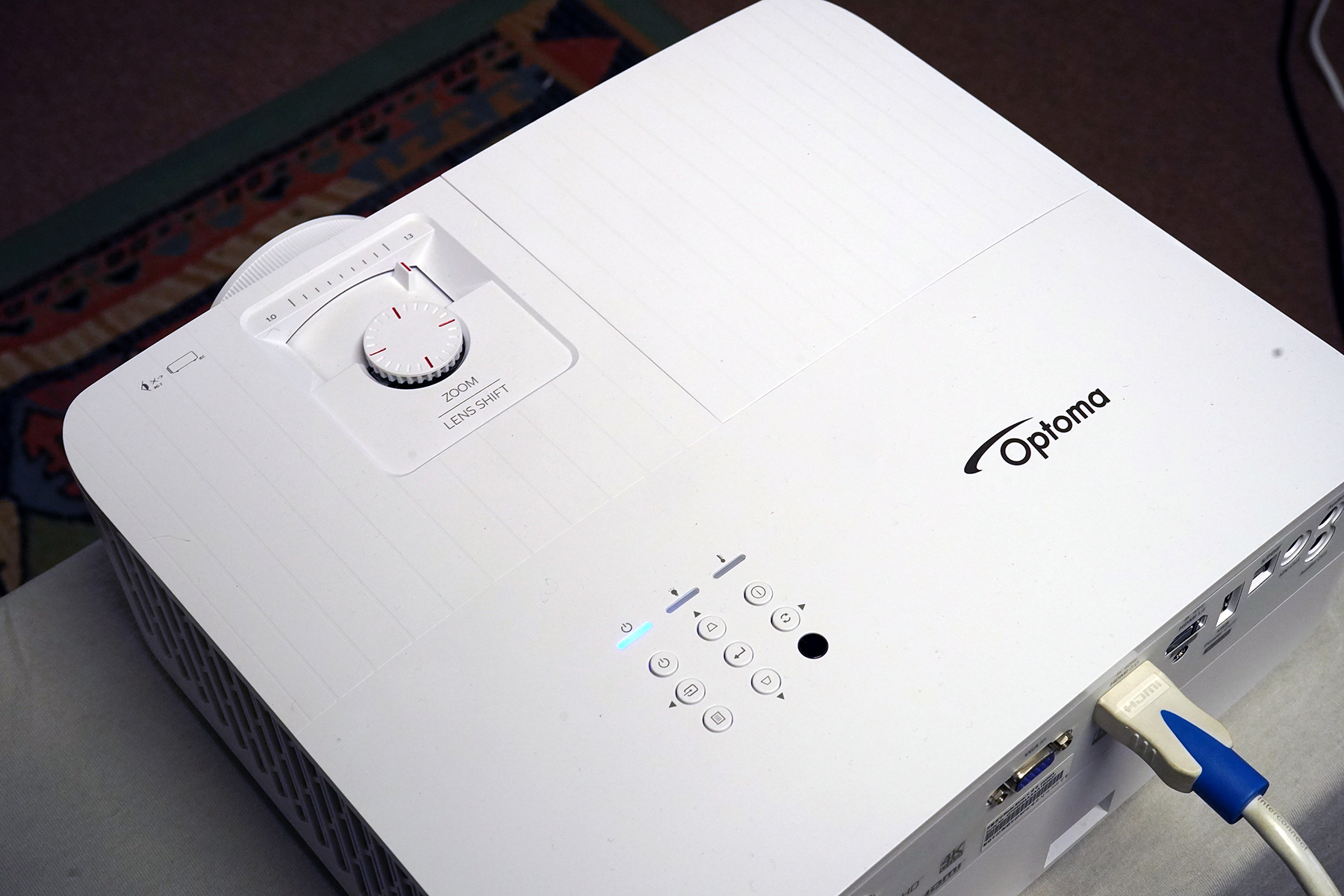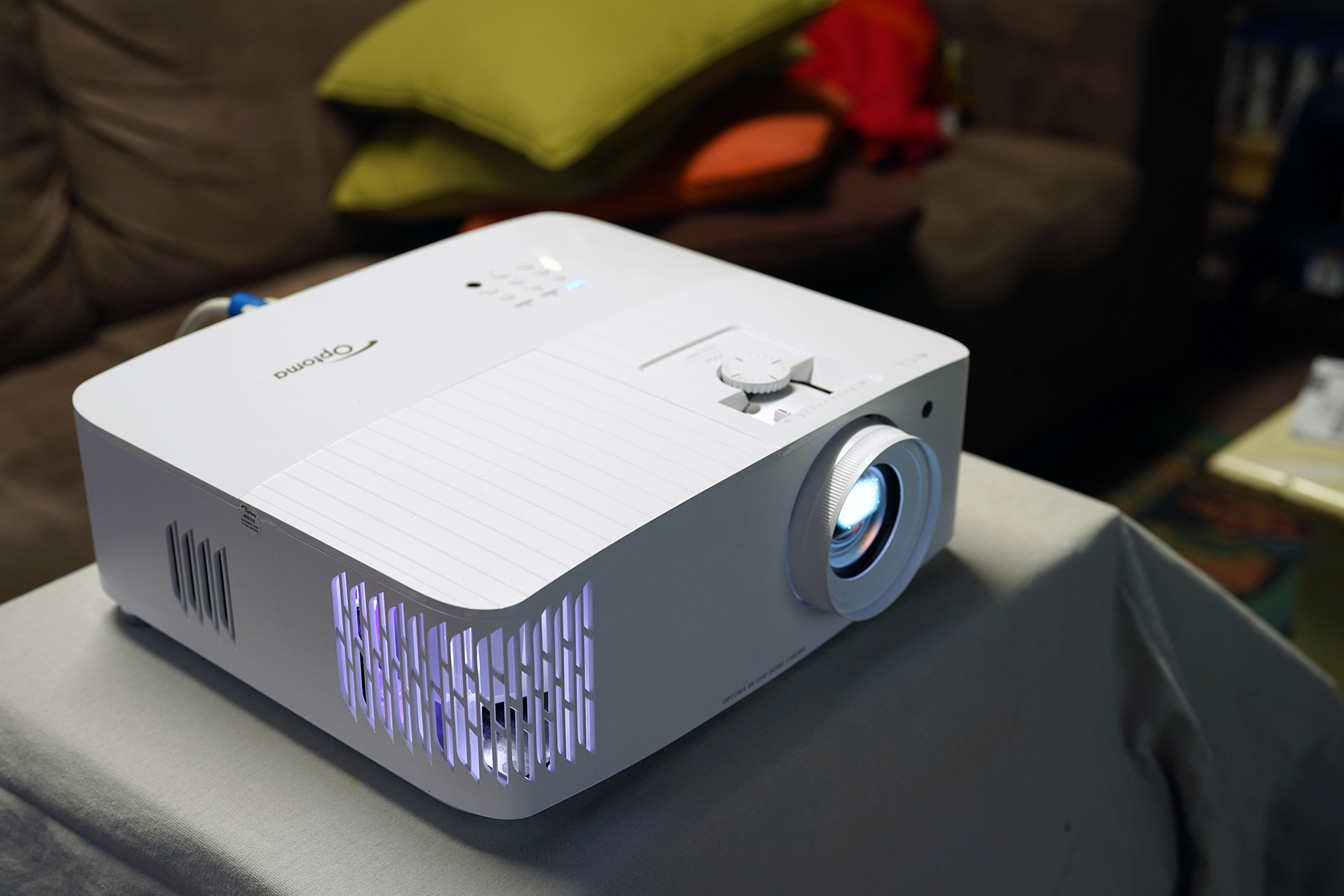Optoma UHD50X
It's clear at whom the Optoma UHD50X projector is chiefly aimed. The very first feature mentioned is: "The World's First 240Hz Cinema Gaming Projector." Since cinema runs at only one tenth that frequency, it's gaming that's the stand-out feature. But there are also plenty of cinema-friendly attributes, like support for HDR 10 and HLG (Hybrid Log Gamma). Let's look into both sides of this DLP projector.
Pricing and availability
The Optoma UHD50X is available in the US and Australia, where it sells for around $1,599 / AU$3,199 respectively.
As is often the case with Optoma projectors, this unit is being sold under a completely different name in the UK and Europe – there, it can be found as the Optoma UHD42 and is priced at roughly £1,199 / €1,499.
Apart from the model numbers, the UHD50X and UHD42 are completely identical.
Equipment
The Optoma UHD50X is an UltraHD 4K DLP projector. It uses a 1080p Digital Micromirror Device with four-way pixel-shifting to generate a true 3,840 by 2,160 pixels. Optoma rates its brightness at a very high 3,400 lumens and contrast ratio at an also very high 500,000:1.
The lamp is rated at up to 15,000 hours of life, depending on the mode you use, although a still impressive 10,000 hours is available in standard brightness.
There are two HDMI inputs along with a D-SUB15 for analogue video. The projector has a ten watt amplifier and speaker built in, so there's also an analogue audio input, along with outputs – analogue and optical digital – so that the projector can offload audio to more competent external speakers.
One of the HDMI inputs conforms to HDMI 1.4 standards – which is 1080p. The other is HDMI 2.0 with HDCP2.2 support. Apparently it also supports MHL 2.1 – a way of connecting Android phones. Most importantly, it supports signals up to 2160p60 and 1080p120. And if you switch on Enhanced Gaming Mode, it can handle up to 1080p240.
The lens has a 1.3:1 zoom range along with vertical lens shift. For a 100-inch (2.54 metre) 16:9 diagonal, the projector needs to be between 2.68 and 3.52 metres from the screen.

Performance
We will get into the that 240Hz thing for gamers later. First, let's look at the Optoma UHD50X as a home theatre projector.
In that function it has a fairly basic feature set. It doesn't offer such things as motion smoothing. But if you switch Dynamic Black on (it's off by default), dark scenes are impressive and blacks are nicely deep.
Without it switched on, black levels were a little muddy and rather uneven, with a brighter patch showing towards the bottom centre of the picture (with the projector operating in desktop mode). We used a meter and found that the brightest section was receiving around 1500 lux, while the dullest corner was treated to only around 800 lux. This difference was virtually unnoticeable with bright material on the screen.
Did this projector deliver real UltraHD resolution? Indeed it did. Our test pattern showed clear delineation of its lines and spaces, each of which occupies only one UHD pixel width or height.
And bright the projector was. Even under the full glare of our office's two fluorescent tubes, the picture was bold, clear and colourful. When we switched out the lights, so much the more so. You can tweak colours to make them more accurate – or to your taste – if you like. But out of the box, the colour settings were very good.
There's also a picture setting for those who find themselves resorting to projecting against a wall of their home. If it's not quite white, the 'Wall Colour' mode adjusts the picture for a more accurate result on surfaces which are 'Blackboard', light yellow, light green, light blue, pink and grey.
It soon became clear that interlaced 50Hz content, both for 1080i50 and 576i50, was simply assumed by the projector to be video-sourced. No attempt was made to detect film-sourced content. While it was motion-adaptive – unmoving parts of the frame were properly woven together to deliver full resolution – for moving sections of the image, a simple 'bob' was being used.
Bob-style deinterlacing takes the first field of the frame and displays it as a full frame for 1/50th of a second, then the second field of the frame, and then repeats for subsequent frames. That generated visible artefacts, particularly on things like finely spaced lines. We'd recommend that you feed the projector progressive scan content only.
It seemed, also, that the projector was locked to 60Hz output – or whole multiples of 60Hz. PAL-style 50Hz from UK, Australian, and European DVDs and broadcast TV juddered noticeably from the 50-to-60Hz conversion. More surprisingly, 24fps content on Blu-ray and UltraHD Blu-ray also juddered (less obviously) due to conversion to 60fps output.
As we'll see, this projector does actually support 120Hz signals, so we'd have thought that 24fps stuff could be displayed at 120Hz – each frame repeated five times – for smoother motion.
One last thing on the picture quality: the test patterns on a Sony UltraHD Blu-ray (tap in 7669 on your UHD player's remote when the disc is on the main menu) showed a smooth graduation of black to white, not limited to the mere 256 levels of an 8-bit signal. The projector works well with HDR signals.

Timing
So, how fast is this projector? This is an all-important thing for gamers. Most action games of any kind rely on fast reflexes. A college student typically has a reaction time of between 200 and 250 milliseconds. If the display adds an additional 120ms – not at all unusual for a 4K TV in regular viewing mode – he or she is going to get shot or run into racecar barriers a lot more than they should.
A computer monitor will typically get this delay down to around 30ms for 1080p60 signals. This projector promises 23.8ms for those signals. That time – the delay between the display device receiving the signal and it appearing on the screen – we call latency or lag.
We use a gizmo we bought from the UK some years ago to check display latency. This has HDMI output, through which it pumps out a signal in 1080p60 format. There's no choice in the format.
It flashes three white boxes on the screen at top left, mid-left and bottom left. You place its sensor over the light (facing the screen if it's a TV, facing the projector if that's what you're using) and the signal shows the latency in milliseconds. It's simple, elegant and, as with all measurements, should be taken with a grain of salt. Is the instrument well calibrated? Is it working properly?
We used the gadget to measure latency with three picture settings. First, in the standard 'Cinema' picture mode, then in 'Game' picture mode. The Enhanced Gaming Mode is a separate setting, so we left the projector in 'Game' mode and switched on Enhanced Gaming Mode for the final measurement.
There were two unexpected aspects to the reported results. The first of these was that the projector measured pretty much the same delay at the top, middle and bottom of the screen. Just about everything we measure has a marked discrepancy, up to around 7 milliseconds between top and middle, and again between middle and bottom.
Why? For video running at 60 frames per second, the time between the start of each frame and the next one is 16.7ms. A computer monitor typically just feeds the content as it is received through to the panel. So each frame is 'painted' onto the screen, from top to bottom using most of that 16.7ms. With a TV, the entire frame is usually accumulated in memory so that it can be processed, and then released to the display panel. That transfer from memory to panel also takes time.
But as far as we could work out, the timing was the same for all three positions with this projector. That would suggest that the transfer of data from the processing memory to the display engine is extremely fast.
'As far as we could work out'? Yes, that was the other odd thing. When we measured the delay in Cinema mode, starting with the middle position, the delay was around 55ms, then 54.9, then 54.8 and so on, reducing by 1ms at a pace of a little more than two seconds per step.
It got all the way down to a mere 41.3ms then the next step took it to... 57.9ms. And the step by step reduction resumed, again bottoming out at 41.3ms before ticking over again to 57.9ms. The results were similar with the regular 'Game' picture mode.
When we switched on Enhanced Gaming Mode, the delay started somewhere around 25 milliseconds, and then it ticked up longer and longer – yes, it went the other way – at about 1ms per second of elapsed measurement time until it got to 28.8ms. And then it ticked over to 24.7ms, and resumed the gradual ticking up again, over and over.
So why? Was our gizmo playing up? We tested it on our computer monitor and it was rock steady on one figure. We tried a TV and again, it was steady on one figure. We went back to the Optoma projector, and it continued ticking upwards or downwards depending on whether 'Enhanced Gaming' was on or off.
We don't really think that if you're gaming you're going to notice any practical difference between 24.7ms and 28.8ms. Nor between either of those and the 23.8ms that Optoma promises for 1080p60 signals. For UltraHD at 60Hz it promises 25.8ms. For 1080p120 it says 18.2ms and for 1080p240, 15.7ms. We couldn't test any of those others.
The fact is, the Optoma UHD50X projector has an extremely low latency mode which will maximise performance for gamers. To compare: that 24.7ms to 28.8ms at top, middle and bottom of the screen compares rather well to the 21.4ms (top), 28.4ms (middle) and 35.5ms (bottom) that we measured on our regular display monitor. And that's pretty much straight through.
And while we could not test the latency at high refresh rates, we plugged our computer's video card into the projector and were able to confirm that it indeed supports 1080p120 and 1080p240.
Note, that does not mean that you'll be getting 120 or 240 animated frames per second from your games. That's the refresh rate. The actual frame rate will depend on your computer and graphics card's rendering performance.

Final verdict
The Optoma UHD50X (known as the UHD42 in the UK and Europe) is an UltraHD projector that's very clearly targeted at gamers – and it does truly deliver what they need. The cinema performance is held back a little by judder, however, especially with PAL (UK/AU/EU) sources. But with most UltraHD Blu-ray and regular Blu-ray content, the results were very good, with sharp, detailed images and a strong colour performance.
0 comments:
Post a Comment